Theology
Our Righteous Father John of Sinai, author of "The Ladder of Divine Ascent"
18. March 2018 - 0:54 St John Climacus of Sinai accepted the ascetical life from the age of about sixteen and was tonsured as a monk three or four years later. Then, at the age of 35, he isolated himself from the world and lived as a hermit for 40 years at a monastery church called Thola, about 10 kilometres from the Mount Sinai monastery.
St John Climacus of Sinai accepted the ascetical life from the age of about sixteen and was tonsured as a monk three or four years later. Then, at the age of 35, he isolated himself from the world and lived as a hermit for 40 years at a monastery church called Thola, about 10 kilometres from the Mount Sinai monastery.
While living an ascetical life he is reported to have received the gift of tears and the grace of continual prayer. Fellow monks in large numbers began to seek him out for spiritual guidance. When criticized for making a mockery of his hermitage by entertaining so many people there, he decided to keep total silence. After a year or so of this, those who had criticized him pleaded with him to resume guiding others.
Experienced both in the solitary life of the hermit and in the communal life of cenobitic monasticism, he was appointed Abbot of the Monastery at Mount Sinai (built at the site of the burning bush where Moses spoke to God). The day he was made Abbot of Sinai, the Prophet Moses was seen giving commands to those who served at the table.
Venerable Gerasimus of the Jordan
17. March 2018 - 14:08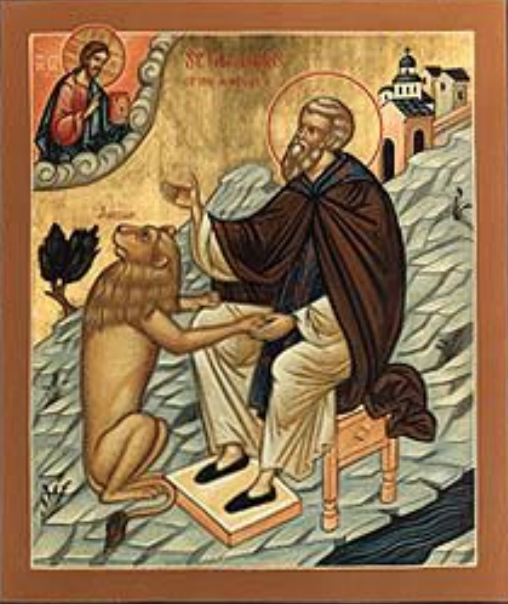 “Father, you burned with heavenly love, preferring the harshness of the Jordan desert to all the delights of the world. Therefore, a wild beast served you until your death; he died in obedience and grief on your grave.” (Kontakion to St. Gerasimus) .
“Father, you burned with heavenly love, preferring the harshness of the Jordan desert to all the delights of the world. Therefore, a wild beast served you until your death; he died in obedience and grief on your grave.” (Kontakion to St. Gerasimus) .
The saying goes that March comes in like a lion and goes out like a lamb. And a lion figures prominently in the story of a Saint who is celebrated on March 17 on the Gregorian Calendar (which is March 4 on the Julian). It is St. Gerasimus of the Jordan – so called to differentiate him from another Gerasimus, the “walking Saint” who is the Patron of the Greek Island of Kephalonia. Gerasimus of the Jordan was born in the province of Lycia near the Mediterranean in the south of Asia Minor (today Turkey). He was an especially serious young man and was still quite youthful when he gave up the comfortable life in the home of his wealthy parents and went to pursue a monastic path in the desert of southern Egypt called the Thebaid because of its proximity to the ancient Egyptian capital city of Thebes. Having gained some maturity by his endeavours and the counsels of fellow desert dwellers, Gerasimus returned to his native Lycia. Later, about 450, he settled in the desert of the Jordan in Palestine where he remained for the rest of his life among other monks. The lives of these men of God were marked by strict asceticism.
Homily on the Third Sunday of Great Lent. On Carrying Your Cross
13. March 2018 - 9:27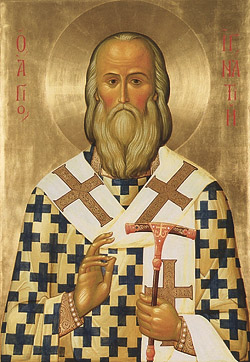 Whosoever will come after me, let him deny himself, and take up his cross, and follow me (Mk. 8:34), said the Lord to his disciples, calling them unto Him, as we heard today in the Gospels.
Whosoever will come after me, let him deny himself, and take up his cross, and follow me (Mk. 8:34), said the Lord to his disciples, calling them unto Him, as we heard today in the Gospels.
Dear brothers and sisters! We too are disciples of our Lord Jesus Christ, because we are Christians. We too are called unto the Lord, to this holy temple, to hear His teaching. We stand before the face of the Lord. His gaze is directed at us. Our souls are laid bare before Him; our secret thoughts and hidden feelings are open to Him. He sees all of our intentions; He sees the truth, and the sins we have committed from our youth; He sees our whole life, past and future; even what we have not yet done is already written in His book.[1] He knows the hour of our passing into immeasurable eternity, and gives us His all-holy commandment for our salvation: "Whosoever will come after me, let him deny himself, and take up his cross, and follow me."
First and second finding of the Honorable Head of the Holy Glorious Prophet, Forerunner, and Baptist of the Lord, John
11. March 2018 - 14:04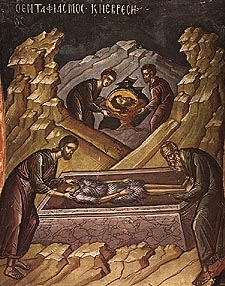 After the Beheading of the Holy Prophet, Forerunner and Baptist John (August 29), his body was buried by disciples in the Samarian city of Sebaste, and his venerable head was hidden by Herodias in an unclean place. Saint Joanna (June 27), the wife of King Herod’s steward Chuza (Luke 8:3), secretly took the holy head and placed it into a vessel and buried it on the Mount of Olives in one of Herod’s properties.
After the Beheading of the Holy Prophet, Forerunner and Baptist John (August 29), his body was buried by disciples in the Samarian city of Sebaste, and his venerable head was hidden by Herodias in an unclean place. Saint Joanna (June 27), the wife of King Herod’s steward Chuza (Luke 8:3), secretly took the holy head and placed it into a vessel and buried it on the Mount of Olives in one of Herod’s properties.
After many years, this property passed into the possession of a government official who became a monk with the name of Innocent. He built a church and a cell there. When they started to dig the foundation, the vessel with the venerable head of John the Baptist was uncovered. Innocent recognized its great holiness from the signs of grace emanating from it. Thus occurred the First Finding of the Head. Innocent preserved it with great piety, but fearful that the holy relic might be abused by unbelievers, before his own death he again hid it in that same place, where it was found. Upon his death the church fell into ruin and was destroyed.
First and second finding of the Honorable Head of the Holy Glorious Prophet, Forerunner, and Baptist of the Lord, John
9. March 2018 - 9:58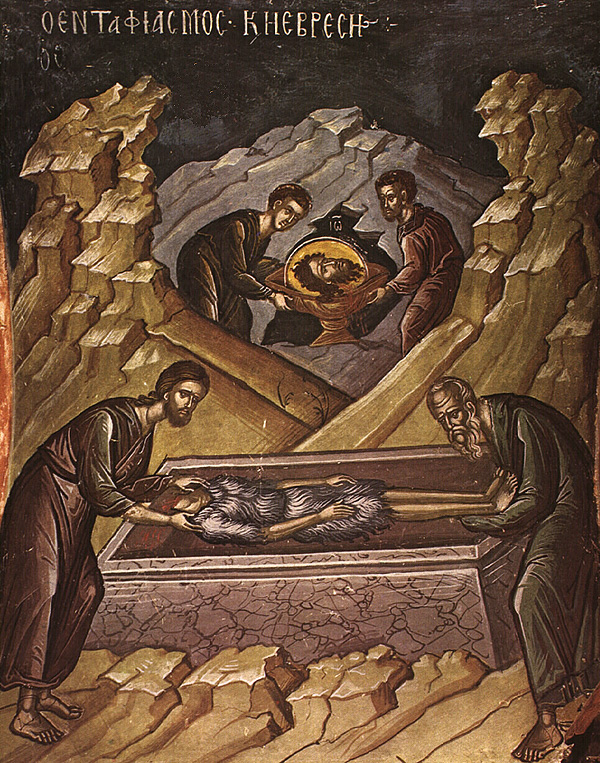 After the Beheading of the Holy Prophet, Forerunner and Baptist John (August 29), his body was buried by disciples in the Samarian city of Sebaste, and his venerable head was hidden by Herodias in an unclean place. Saint Joanna (June 27), the wife of King Herod’s steward Chuza (Luke 8:3), secretly took the holy head and placed it into a vessel and buried it on the Mount of Olives in one of Herod’s properties.
After the Beheading of the Holy Prophet, Forerunner and Baptist John (August 29), his body was buried by disciples in the Samarian city of Sebaste, and his venerable head was hidden by Herodias in an unclean place. Saint Joanna (June 27), the wife of King Herod’s steward Chuza (Luke 8:3), secretly took the holy head and placed it into a vessel and buried it on the Mount of Olives in one of Herod’s properties.
After many years, this property passed into the possession of a government official who became a monk with the name of Innocent. He built a church and a cell there. When they started to dig the foundation, the vessel with the venerable head of John the Baptist was uncovered. Innocent recognized its great holiness from the signs of grace emanating from it. Thus occurred the First Finding of the Head. Innocent preserved it with great piety, but fearful that the holy relic might be abused by unbelievers, before his own death he again hid it in that same place, where it was found. Upon his death the church fell into ruin and was destroyed.
Hieromartyr Polycarp the Bishop of Smyrna
8. March 2018 - 16:34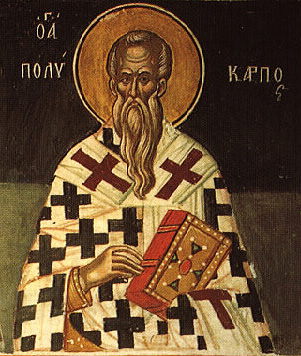 Saint Polycarp, Bishop of Smyrna, who was “fruitful in every good work” (Col. 1:10), was born in the first century, and lived in Smyrna in Asia Minor.
Saint Polycarp, Bishop of Smyrna, who was “fruitful in every good work” (Col. 1:10), was born in the first century, and lived in Smyrna in Asia Minor.
He was orphaned at an early age, but at the direction of an angel, he was raised by the pious widow Kallista. After the death of his adoptive mother, Polycarp gave away his possessions and began to lead a chaste life, caring for the sick and the infirm. He was very fond of and close to Saint Bucolus, Bishop of Smyrna (February 6). He ordained Polycarp as deacon, entrusting to him to preach the Word of God in church. He also ordained him to the holy priesthood.

